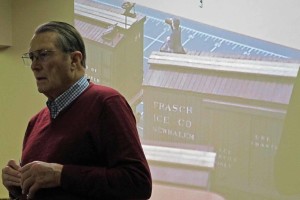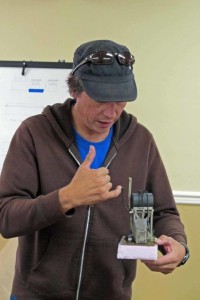Tom Buckingham & Al Frasch / Photos by Al Frasch
Rich Blake kicked off the October Skagit Valley & Whidbey NMRA Clinic to more than 30 eager model railroaders by reminding everyone of the full slate of fall swap meets, expo’s and clinics. Of note were the Pacific Northwest Railroad Prototype Modelers Meet “Rail By the Bay” on October 26th, The Anacortes & Fidalgo Model Railroad Club’s 18th Annual Open House on November 2nd and 3rd, The Boeing Employees Model Railroad Club Swap Meet on November 9th and finally the Burnaby, British Columbia 2013 Model Train Show & Meet November 9th & 10th.
The feature presentation was the much heralded Four Mini-Clinic Clinicfest. The first presenter was John White discussing “Dry Print Lettering for Rolling Stock and Buildings.” John had a nice handout of all the tools and materials required to do a professional-looking job. He started by the choices in fonts and colours (the spelling is out of respect to John). Though there are two good “railroady” font choices—Gothic and Roman, John urged us to choose only one or “inevitably a Gothic letter will end up in a line of Roman print.” Although the fonts are available in White, Black, Red, Yellow, Silver and Gold, John said he had had no luck with Gold with very high wastage.  Perhaps the most valuable part of John’s comments were his tips that only experience can bring: Choose the name of your pike carefully—there are only two “V’s” per sheet; write down what you intend to decal—sometimes you have to spell backwards (try spelling Skagit backwards quickly without looking!); use a piece of blue or white masking tape to mark the edge of the lettering but be sure to cut off about ¼” so no “hairy” bits stick out on the original tape edge; don’t miss space between words; use a clean (preferably white) piece of paper towel to place on your workbench to prevent the decal sheet from picking up dirt form your workbench; and lastly check your work before burnishing the letters. John closed by discussing difficult locations and repairs.
Perhaps the most valuable part of John’s comments were his tips that only experience can bring: Choose the name of your pike carefully—there are only two “V’s” per sheet; write down what you intend to decal—sometimes you have to spell backwards (try spelling Skagit backwards quickly without looking!); use a piece of blue or white masking tape to mark the edge of the lettering but be sure to cut off about ¼” so no “hairy” bits stick out on the original tape edge; don’t miss space between words; use a clean (preferably white) piece of paper towel to place on your workbench to prevent the decal sheet from picking up dirt form your workbench; and lastly check your work before burnishing the letters. John closed by discussing difficult locations and repairs.
The second presenter was Rich Thom with “Having Fun in a Cramped Space” Rich talked about some problems encountered when he tried to cram too much operation—and too much track—in a small room: lots and lots of no. 4 turnouts; wye turnouts; tracks too close to layout edges; 4.5% grades, etc. Lack of planning also placed L-girders directly beneath a series of turnouts, so when he decided to use Tortoises to throw them rather than oversize ground throws, he had to make a number of simple brackets to extend the “reach” of the switch motors. They are simple and versatile and can be used in any situation where one needs to locate a switch motor some distance away from what it is moving. Rich wrote an article for the April 2013 Model Railroader on construction of the brackets (page 60).
Our third mini-clinic was by Cliff Aaker on “Making Hemlock Trees.” Using bamboo skewers for tree trunks, Cliff first runs a bead of glue along the skewer where he wants the branches to be. Next he takes fibers that he has separated from a hank of manila rope and cut to approximate limb length and sprinkles them randomly on the now sticky tree trunk. After that dries, he trims the limbs to a reasonable and appropriate length and dips the entire skewer in a dark walnut furniture stain. When the stain has dried he rotates the tree branches in glue and then sprinkles them with his favorite tree foliage. Cliff had samples at the various stages in the process with him and it took an unbelievably short time to produce a very realistic hemlock.
Finally, what do the following items have in common: the foil from wine bottles, aluminum cut from pop cans, coffee stir sticks from your favorite barista, plastic bottles, dog toy stuffing, pencil shavings, used guitar strings, short lengths of solder, rhododendron cuttings, and rotted wood? We found out when Rich Blake showed us how he does “Scratchbuilding with Common Materials.” Rich told us how as a young modeler he had little financial resources to buy the “proper” materials so he used his imagination and commonly available materials to get the job done—always at a cheaper price and often better looking that the “real McCoy.” One example was to make door hinges complete with bolt heads using the foil from wine bottles and a dulled map pin. Another was using pencil shavings colored with acrylic paint to make clumps of flaking foliage. Finally he showed how he used an old dead Walkman to scavenge parts that can be used on models.
All-in-all a fun night in Oak Harbor.


